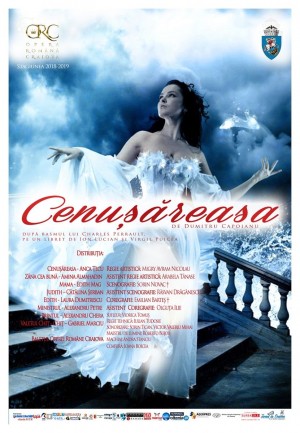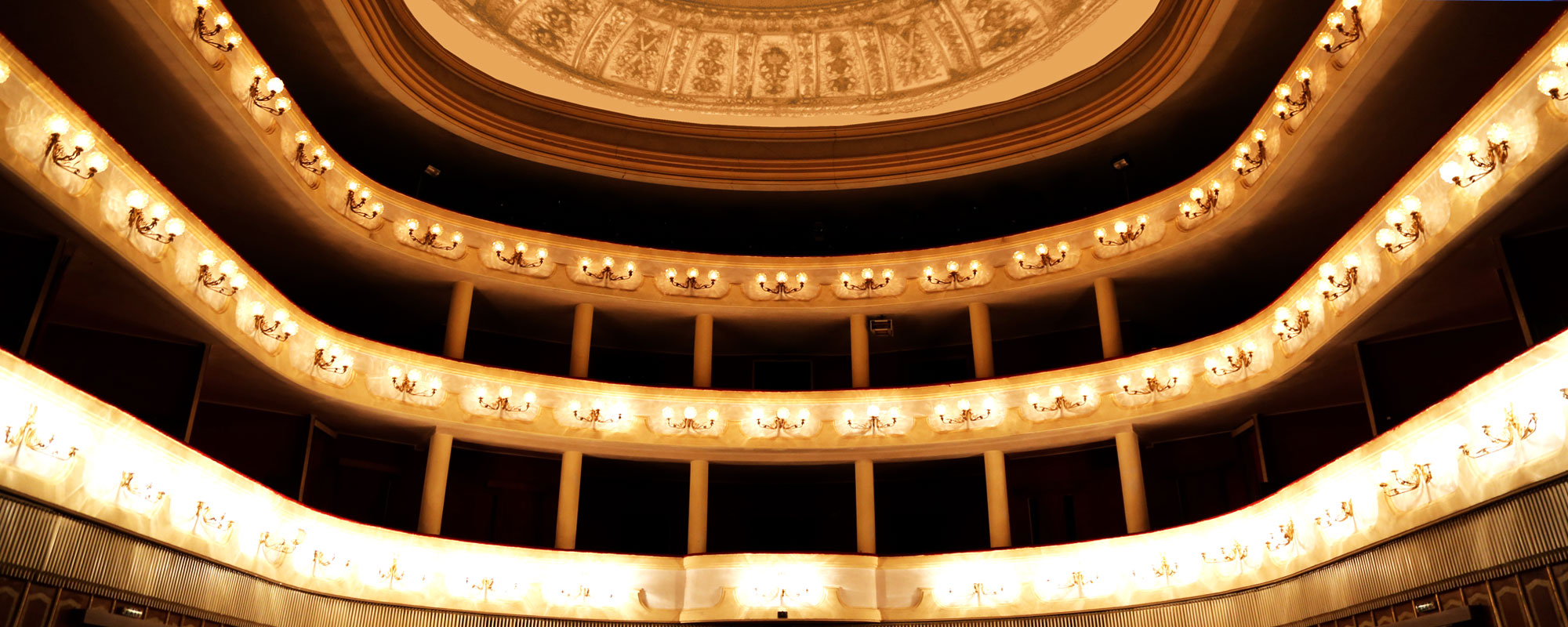Cenușăreasa
Dumitru Capoianu

- Romanian Opera Craiova Premiere
- 29 octombrie 2012
- Time Length
- aprox. 2h – o pauză
- Extra info
- Spectacol în limba română
Musical in two acts, composed by Dumitru Capoianu.
Story (libretto) by Charles Perrault, as published in Histoires ou Contes du temps passé în 1697.
Romanian version of the libretto: Ion Lucian and Virgil Puicea.
Spectacol susținut de Opera Română Craiova pe scena Cercului Militar
Regie artistică: Migry Avram Nicolau
Asistent regie artistică: Arabela Tănase
Scenografie: Sorin Novac +
Asistent scenografie: Răsvan Drăgănescu
Coregrafie: Emilian Barteș +
Asistent coregrafie: Olguța Ilie
Sufleur: Viorica Tomuș
Regie tehnică: Iulian Tudosie
Sonorizare: Sorin Tican, Victor Valeriu Mihai
Maestru de lumini: Roberto Bujor
Machiaj: Andra Stanciu
Coafură: Ioana Boicea
Distribuţia:
Cenușăreasa - Anca Țecu
Zâna cea bună - Amina Almahadin
Mama - Edith Mag
Judith – Andreea Enache
Edith - Laura Dumitrescu
Ministrul - Alexandru Petre
Prințul – Laurențiu Nicu
Valetul Chiț - Chiț - Teodor Ispas
Baletul Operei Române Craiova
Cinderella (Cendrillon in French) is a popular fairy tale embodying the mythical element of unfair oppression, followed by triumph and reward. Thousands of versions of the fairy tale are known all over the world. The main character is a young girl experiencing an unhappy situation and whose fate changes. By analogy, the very word Cinderella has come to refer to “a person whose qualities are not recognised or are recognised after some time of obscurity and negligence”. The popular story of Cinderella influences international popular culture, as it is transposed to other artistic works through elements of action, suggestions and motifs.
The oldest European version of this theme of Cinderella is the one entitled “La Gatta Cenerentola” or “Cinderella the Cat”, which appears in “Il Pentamerone, by Italian fairy tale collector Giambattista Basile in 1635. This lies at the basis of the subsequent versions published by French author Charles Perrault and the Grimm Brothers. (The fairy godmother is not present in the version of the Grimm Brothers, as the spirit of Cinderella’s mother is represented by two birds in the tree next to her tomb.)
One of the most popular versions of the fairy tale is the one written by Charles Perrault in 1697. The popularity of the story is due to the fact that Perrault added the pumpkin, the fairy godmother and the glass shoes. English speakers mistakenly thought that in Perrault’s version Cinderella wore fur shoes (pantoufle en vair) and that, when the story was translated into English, vair (fur) was mistaken by verre (glass) and the story was left like this. The fur shoe theory was infirmed.
Another famous version is the one written by brothers Jacob and Wilhelm Grimm in the 19th century. The story is entitled “Aschenputtel”, and the help is provided by the tree on the mother’s tomb. In this version, the stepsisters try to trick the prince, cutting off parts of their feet in order to make the shoe fit. The prince is informed by two pigeons who take off the eyes of the stepsisters, turning them into blind beggars for the rest of their lives.
The first moral of the story is that beauty is a treasure, but kindness is invaluable. Nothing is possible without it, while one can do everything with it.
However, the second moral of the story somewhat diminishes the first one and reveals the criticisms envisaged by Perrault: “Another moral: it is undoubtedly a huge advantage to have intelligence, courage, education and common sense. Any many other similar qualities. Talents only come from above and it is good to have them. However, even when you have them, you may not have the expected success without the blessing of a godparent.” Across the years, the story of Cinderella has lied at the basis of notable works in fields such as opera, ice ballet, theatre, pantomime, film and television.
ACT I
Cinderella is a beautiful girl who is left alone in the world and has to go live with her stepmother, being excluded from the family and becoming a servant in her own home. When he wants to go to the ball, the stepmother does not allow her to wear her older clothes, even though they were very beautiful, but gives them to her daughters, so that they should be the prettiest at the palace ball and so that at least one of them would manage to impress to prince. Left alone and weeping over her fate, the girl is surprised by a fairy who manages to make her pretty for the ball that is about to start. Thus, she orders the valet, who is no one else but the mouse Eek-Eek, to bring an elegant ball dress to Cinderella, and she will turn the “pumpkin on the terrace” into a “wonderful carriage”, the two lizards living below “the beams of the fountain” into “two quick horses to be attached to the carriage”, and the “old crow, nesting in the oak tree of the garden” into “a great cab driver”, who will drive Cinderella to the ball.
ACT II
As she arrives at the ball, Cinderella’s beauty cannot be ignored. Everyone sees that she is wonderful, and what seems most interesting and unusual is the fact that she has crystal-like shoes, something no one had seen before. The prince watches her fascinated with her beauty and dances with her all night. The girls who were there were struggling to conquer him, but they had no change, since his gaze was already fixated on a single person. Cinderella could not believe that it was happening, but the condition established by the fairy (her godmother) was that she should come home by midnight, as everything would turn back to its original state: the cab driver into the crow, the horses into lizards, the carriage into a pumpkin and the valet into the mouse Eek-Eek.
The two fall in love, they spend the entire evening together, no one could separate them, but the clock begins to strike midnight, her comeback time.
As Cinderella and the valet leave the palace in a hurry, the girl loses a shoe.
The next day, the prince takes the shoe and leaves to find the girl who lost it, determined that the only person the shoe will fit perfectly will be his chosen one.
After he wanders through the entire kingdom, he finds the owner of the shoe, they get married and they live happily ever after.
* Programme book from the resumption of the show on October 29, 2012.

